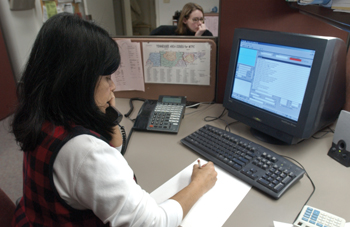
Isabel Fiala, RN, (foreground) and Dr. Stephanie Horn, an ER resident on her toxicology rotation, answer phones in the Middle Tennessee Poison Center at Vanderbilt University Medical Center. The center is now the only one of its kind in the state. Photo by Dana Johnson
Nursing bylaws convention marks changes
A representative from every unit, clinic, and procedural area of Vanderbilt University Medical Center, both on- and off-site came together in Light Hall recently to revise and pass updated nursing bylaws, and to begin a process of creating a well-defined structure for nursing at Vanderbilt.
Putting the bylaws back to use at VUMC defines the philosophy of nursing at Vanderbilt, allows nurses to share ideas and decision-making, and redefines areas of patient care and accountability.
“It creates the structure which allows staff to set and maintain the standards for their own clinical practice and the quality of their work environment,” said Marilyn Dubree, MSN, director of Patient Care Services and Chief Nursing Officer.
“It’s such an important thing for nursing. It strengthens our profession,” said Karen Robinson, MSN, who works in case management at VUMC and was present for the convention.
Dubree told the crowd of delegates from around the Medical Center that reinstating the bylaws and coming together for the convention builds on the work that has already been taking place as part of the Medical Center’s “be the best, keep the best” campaign.
Norman Urmy, University Hospital chief executive officer, was on hand to support the work being done by the nursing staff.
“I think Vanderbilt has the best nursing staff in Tennessee, and maybe even the entire Southeast,” Urmy said. “To have the best hospital, you have to have the best nursing staff,” he added.
The event marked the first time since 1996 that VUMC has held a bylaws convention, typically held every two years. Robin Steaban, MSN, administrative director of Cardiovascular and Inpatient Medicine Patient Care Centers, and a co-chair of the Bylaws Committee said updating the bylaws is long overdue.
“The bylaws were outdated and have been since around the time that the hospital reorganization took place,” said Steaban. “We were less coordinated and probably less effective, to be honest. We have had no governing document to coordinate nursing efforts, and people were doing the best they could,” she added.
Dubree said the nursing staff will continue working together as they move forward under the new guidance of the bylaws.
“We still have much work to do and we will have another convention next fall because we have so many issues to respond to in a timely fashion,” Dubree said.
The work to reinstate the nursing bylaws goes hand in hand with applying the shared governance model of training for nurses at VUMC, which should be completed by June. In turn, Dubree hopes both measures combined will lead to the Medical Center achieving Magnet Status in nursing care by December of 2005.
Magnet is the highest award an organization can receive for nursing care as established by the American Nurses Credentialing Center, a division of the American Nurses Association.













